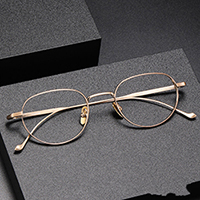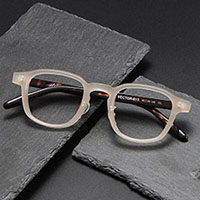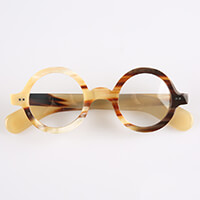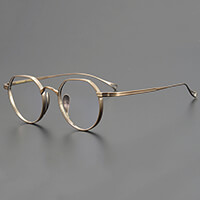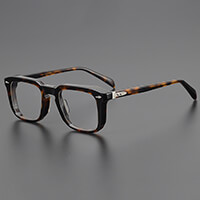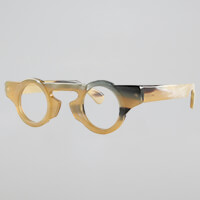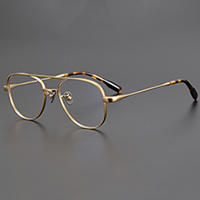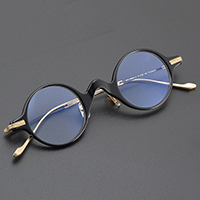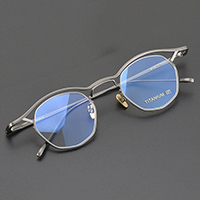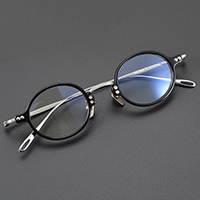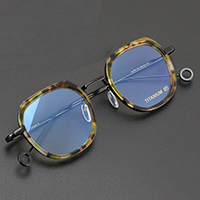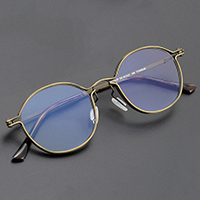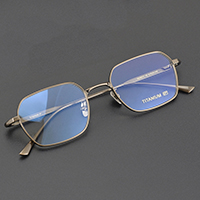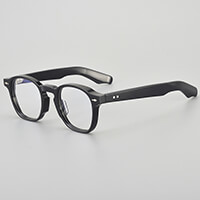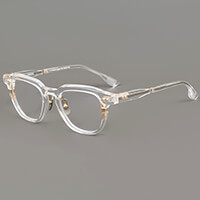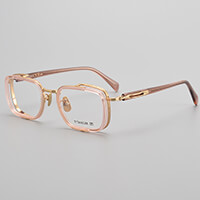What are Progressive Glasses? Ultimate Guide2024-05-26
Imagine a landscape painting that gradually shifts from day to night, portraying every nuance in between. Like this painting, progressive glasses blend various prescriptions seamlessly.
A close friend once mentioned how disconcerting abrupt vision changes felt.
Progressive glasses offer a sophisticated solution for those experiencing presbyopia, allowing smooth transition between distances without visible lines.
What Are Progressive Glasses?
Progressive glasses, also known as no-line bifocals, are multi-focal lenses designed to correct presbyopia.By providing a seamless gradation of increasing lens power, these glasses allow wearers to see clearly at any distance without the abrupt transitions associated with traditional bifocals or trifocals.
The term “progressive” or “no-line” uniquely underscores the absence of the 'bifocal line'.
Definition and Features
Progressive glasses, also known as multifocal lenses, provide a seamless transition between different lens powers. This eliminates the visible lines seen in bifocal or trifocal lenses.The top portion of the lens is designated for distance vision, while the middle and bottom sections cater to intermediate and near vision, respectively.
|
Progressive lenses allow for a more natural visual experience compared to traditional bifocals. |
Wearers benefit from various visual fields in one lens, making progressive glasses ideal eyewear options for individuals who need correction for multiple vision issues (e.g., myopia and presbyopia). However, it does take some time to adjust to the lens due to the gradual change in strength, which can help reduce eye strain.
Differences from Bifocals and Trifocals
Progressive lenses, unlike bifocals and trifocals, provide a seamless visual experience without any visible dividing lines.- No Visible Lines: Progressive lenses lack the distinct lines found in bifocals and trifocals, enhancing aesthetic appeal.
- Smooth Transition: They offer a gradual shift between different prescription strengths, allowing for clear vision at all distances.
- Intermediate Vision: Progressives provide a more comprehensive intermediate vision zone, which is often limited in bifocals.
- Customization: These lenses can be more precisely tailored to an individual’s visual needs compared to conventional bifocals and trifocals.
This seamless design offers a more natural viewing experience.
Progressive lenses are often preferred due to their discrete appearance and functionality.
However, the smooth gradient of lens power may require an adaptation period for new wearers.
Who Needs Progressive Glasses?
Progressive glasses are primarily designed for individuals experiencing presbyopia, an age-related condition where the eye's lens loses elasticity, making it difficult to focus on close objects. This typically appears around the age of 40, but the need can vary based on individual circumstances.Individuals who require multiple prescription strengths for different viewing distances—such as for reading, computer use, and distance vision—are ideal candidates for progressive lenses. They offer a corrective and seamless transition across various distances, providing a versatile and convenient solution.
Ideal Candidates
Ideal candidates encompass various demographics.Progressive glasses are particularly beneficial for individuals over the age of 40 experiencing presbyopia. This condition compromises the eye's ability to focus on nearby objects, necessitating multiple prescription strengths for near, intermediate, and distance vision. Consequently, those facing such visual changes find progressive lenses highly advantageous.
Professionals benefit greatly.
This group often includes office workers, academics, and anyone who frequently shifts focus between reading materials, computer screens, and across rooms, making prescription glasses a valuable tool. Their need for seamless transitions without changing glasses makes them ideal users of progressive lenses.
Though mostly advantageous, adaptation is crucial. Effective use requires a brief adjustment period where individuals learn to look through different parts of the lens. Proper alignment and fitting of the lenses also enhance effectiveness.
In sum, progressive glasses serve as a versatile solution for those experiencing presbyopia. They offer clear vision at all ranges, but careful consideration of one's specific needs and an adaptation period are essential for optimal use. Matching the right individual with the proper lens can significantly improve visual quality and comfort.
Age and Vision Requirements
Progressive glasses are mostly for adults.Typically, people begin needing them in their 40s. This period marks the onset of presbyopia, a natural age-related condition where the eye's lens gradually loses flexibility, making it challenging to focus on close objects. Consequently, most users are in their mid-40s or older, as the condition progresses and the advantages of having multiple focal lengths in one lens become apparent.
Younger adults might not need them.
Eye specialists assess each patient. If vision changes significantly - not just due to age but also because of complex prescription needs - a doctor might suggest progressive lenses.
Optical professionals recognize the importance of addressing young patients' specific visual requirements with solutions tailored to their developmental stages. That said, anyone experiencing difficulties focusing at various distances should consult an optometrist to determine if progressive lenses offer the desired clarity and comfort.
Are Progressive Glasses Right for Everyone?
Progressive glasses are designed to offer a seamless transition between different focal lengths, accommodating near, intermediate, and distance vision. However, while they are an excellent solution for many, not everyone will find them suitable or comfortable.Some individuals might experience initial challenges, such as distortion or discomfort, which could deter them from adapting to progressive lenses. Consulting with an optometrist is essential to ensure the right choice.
Benefits and Drawbacks
Progressive glasses offer a multitude of advantages for those dealing with presbyopia or other vision issues. These lenses provide seamless transitions between varying focal points, reducing the need to switch between multiple pairs of glasses.One significant benefit is the convenience they offer. There is no need to juggle different spectacles for reading, computer work, and driving.
However, while progressive lenses can be beneficial, they can carry a steeper learning curve. It may take time to adapt to the distortions at the lens edges, and some users may experience discomfort initially.
Moreover, the cost can be a drawback. Progressive lenses tend to be pricier than single-vision or bifocal lenses due to their advanced design and complex manufacturing process. It's crucial to weigh these factors and consult with a knowledgeable optometrist for personalized advice and fitting. Remember, expert consultation can significantly ease the transition and maximize the benefits of progressive glasses.
Common Adaptation Issues
Adapting to progressive lenses can present several challenges, particularly for first-time users.1. Peripheral Distortion: Users might notice blurriness at the edges due to the gradual shift in lens power.
2. Visual Swim Effect: Rapid head movements can cause a sensation of motion, often described as a "swim" effect.
3. Adjusting to Different Zones: Learning to use the top, middle, and bottom portions of the lens effectively can be daunting.
4. Depth Perception Changes: Initial use can alter depth perception, making stairs or curbs appear distorted.
5. Longer Adaptation Period: It often takes several days to weeks for eyes and brain to fully adjust to the lens.
It is crucial for wearers to have patience during the adaptation period.
Proper guidance from an optometrist can mitigate many of these initial challenges.
Key Considerations for Progressive Glasses
When selecting progressive glasses, understanding one's visual requirements is paramount for optimal vision correction.One should consider lifestyle needs, including reading, computer work, and driving, to ensure all activities are well-supported by the lenses. Additionally, the frame choice is vital in accommodating the larger lens size required for progressives.
Frequent consultations with a qualified optometrist will ensure the prescription is precise and properly adjusted.
Tips for Choosing the Right Pair
Choosing the right pair of progressive glasses requires careful consideration.Firstly, it is essential to work with a reputable optometrist who can assess your specific vision needs, lifestyle, and occupation. Their expertise will guide you in selecting lenses that offer seamless transitions between different focal points. Always ensure your prescription is up-to-date before purchasing new glasses.
Additionally, pay special attention to the frame design and fit. Progressive lenses are generally larger, so selecting a frame that comfortably accommodates the lens size is critical. When selecting the right progressive glasses, it is advisable to opt for rectangular frames or square glasses with a height between 35mm and 48mm. This will ensure that you get a comfortable pair of progressive lenses. A well-fitted frame can dramatically improve comfort and functionality, making everyday activities more manageable.
Lastly, consider the quality of the lens materials and coatings, such as anti-reflective or scratch-resistant treatments. These enhancements can significantly improve the durability and performance of your glasses. Opting for high-quality lenses ensures better visual clarity and longevity, making the investment worthwhile. Proper care and maintenance of your progressive glasses will also extend their usability and effectiveness.
How to Adjust and Care for Them
Adjusting to progressive glasses can take some time, but proper care can ease this transition significantly.1. Gradual Adjustment: Wear your new progressive glasses for a few hours each day, gradually increasing the time.
2. Head Movement: Use head movements to look through the appropriate section of the lenses rather than just moving your eyes.
3. Practice Reading: Spend time reading to get used to the small adjustment in the reading sections of the lenses.
4. Maintenance: Clean lenses regularly with a microfiber cloth and lens cleaner to ensure optimal vision.
5. Professional Adjustments: Visit your optician for adjustments if you experience discomfort or visual distortions.
Adapting to these glasses might require patience, but consistent wear will help facilitate the transition.
Proper storage in a hard case when not in use can prevent scratches and other damages.
- About Olet Optical
- Affordable Glasses Online for Every Budget
- Contact Us
- Customer Reviews
- Returns & Replacements
- Shipping & Payment
- Privacy Policy
- Infringement Policy
- Site Map
- Olet Blog
- User Center
- Register
- My Account
- Forget Password
- My Orders
- Tracking Order
- Refer a Friend
- Customs & Taxes
- Influencer Program
- Measure Your PD
- Measure Frame Size


Copyright © 2024 Olet Optical. All Rights Reserved











